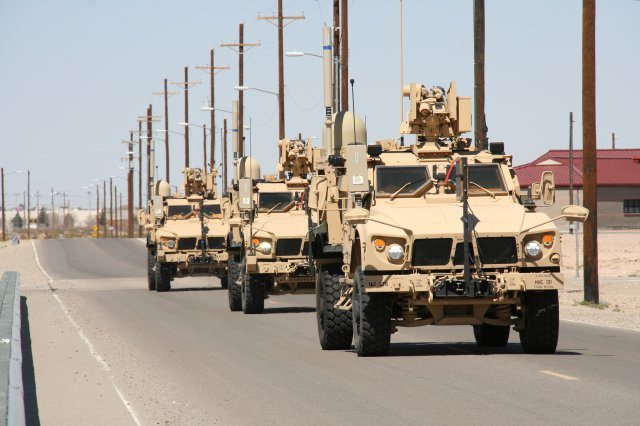In advance of this spring’s major field exercise for the Army’s new tactical communications network, engineers are putting systems through their paces to ensure a smooth handoff to the troops conducting the evalutions.
This will be the first Network Integration Evaluation, or NIE, for which the Army has used new laboratories at Aberdeen Proving Ground to conduct assessments and mitigate risk prior to an NIE start. Over the last several months, that activity has narrowed the list of government and industry products participating in the field exercise, and lightened the integration burden for the Soldiers and engineers who execute the NIE at Fort Bliss, Texas, and White Sands Missile Range, N.M.
The lab-based risk reduction represents a key step as the Army implements its new Agile Process for developing, testing and buying the network gear that will connect all echelons of a brigade combat team with real-time voice and data, even while moving across the battlefield.
“We’ve got to share information no matter where we’re at, and it’s got to be relevant and it’s got to be timely,” said Col. John Morrison, director of the Army G-3/5/7 LandWarNet-Battle Command Directorate.
“This is a fundamental change in the way we are acquiring, testing, evaluating and then fielding network capabilities to our operational formations,” he added. “This is a change in how we do business. And like any big change in how you do business, there are things that are challenging to us as we work our way through.”
NIE 12.2, which will take place in May and June, is the third and most significant such exercise the Army has conducted. It will equip the 3,800 Soldiers of the 2nd Brigade, 1st Armored Division, with the entire network architecture of Capability Set 13, an integrated package of vehicles, network components, and associated equipment and software that will be fielded to Army brigade combat teams beginning in fiscal year 2013.
The realistic on-the-move missions conducted by 2/1 AD, along with a higher headquarters element of the 101st Airborne Division operating out of Fort Campbell, Ky., will serve to validate and finalize the components of Capability Set 13. A battalion-sized opposition force will be employed in dynamic scenarios with hybrid threats, including conventional forces, insurgents and members of the local population.
“We will test the holistic network in a realistic operational environment, the way it’s going to be fielded,” said Maj. Gen. N. Lee S. Price, program executive officer for Command, Control and Communications-Tactical, known as PEO C3T. “We will be able to see the operational effects of that connectivity.”
Prior to receiving a field tryout with Soldiers, network capabilities must pass through the laboratories at Aberdeen Proving Ground for technology evaluation, assessment and integration. Systems are tested individually and as an integrated network that replicates the structure of what will be fielded to the 2/1 AD, allowing engineers to resolve interoperability issues so Soldiers can focus on performance once the equipment is delivered for the exercise. At previous NIEs, many of these issues had to be worked out on the ground at Fort Bliss and White Sands.
The lab assessments are intended to inform the Army’s choices on what systems will participate in the NIE and provide detailed “score cards” to industry on how their technologies performed and what could be improved in the future. The Agile Process and Capability Set Management rely on industry to propose solutions to capability gaps, which the Army defines and updates on a regular basis to keep up with the pace of technology development. The Army is also using the NIEs to establish an integrated network baseline to ensure common standards for interoperability.
“We’re not building a radio, but we’re telling industry, ‘This is what the radio needs to do, and this is how it fits into the architecture, so this is what we need you to go build,'” said Jennifer Zbozny, chief engineer for PEO C3T. “So industry brings that piece of equipment. and the government is taking all those products and building the glue to make those things work together.”
Built as part of the recent Base Realignment and Closure move of Command, Control, Communications, Computers, Intelligence, Surveillance and Reconnaissance, known as C4ISR, organizations to Maryland, the laboratories are linked through direct fiber optic connectivity — creating an integrated environment for government and industry to measure system performance and interoperability. The facilities that support the NIE, Agile Process and capability set fielding include settings focused on tactical radios, satellite communications, intelligence, mission command applications and the integration of C4ISR equipment onto various vehicle platforms.
For NIE 12.2, for example, more than 100 system candidate white papers were submitted to APG labs operated by the Communications-Electronics Research, Development and Engineering Center, or CERDEC, during Phase 1 of the Agile Process. Of those, less than half were selected to participate in the lab tests in Phase 2. Following these evaluations, another smaller subset of vendor systems were approved to participate in the actual NIE, officials said.
“We’re now spending a lot more time on the earlier phases of that Agile Process, doing the candidate assessments and integration before it actually goes out to NIE,” said Seth Spoenlein, lab director for CERDEC. “The campus here at APG provides an integrated look at what that network will be not just for NIE, but also for capability set fielding.”
Some of the lab resources will continue to be built out and improve for future NIEs, including 13.1 this fall, Morrison said.
“We are nine months into executing the NIE construct, and it is a maturing process,” he said. “We have turned this ship very quickly.”










